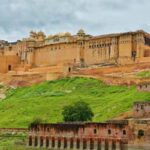Top 10 Heritage Places in Rajasthan, known as the “Land of Kings,” is a treasure trove of heritage places that reflect its rich history and royal legacy. The state’s majestic forts, palaces, and historic sites offer a glimpse into its grand past.
The iconic Amber Fort in Jaipur, with its intricate mirror work and sprawling courtyards, is a must-visit. Jaipur also boasts the City Palace and the Hawa Mahal, known for its unique architecture and historical significance.
In Udaipur, the City Palace stands tall along the shores of Lake Pichola, offering stunning views and a peek into royal life. The Lake Palace, now a luxury hotel, seems to float on the lake’s waters, creating a mesmerizing sight.
Jodhpur’s Mehrangarh Fort is an imposing structure that dominates the skyline, showcasing exquisite craftsmanship and a rich collection of artifacts. Nearby, the Umaid Bhawan Palace, part of which is a heritage hotel, adds to the city’s regal charm.
Jaisalmer, the “Golden City,” is home to the magnificent Jaisalmer Fort, a living fort with shops, hotels, and ancient havelis within its walls. The intricately carved Patwon Ki Haveli is another highlight.
Other notable heritage sites include the Kumbhalgarh Fort, known for its massive walls, and the Chittorgarh Fort, a symbol of Rajput valor and sacrifice.
Each of these heritage places in Rajasthan tells a unique story, making the state a captivating destination for history enthusiasts and travelers alike.
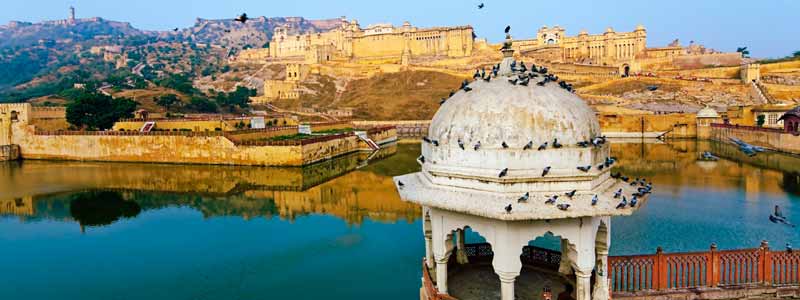
Amber Fort, Jaipur
Amber Fort, located in Jaipur, Rajasthan, is one of the most prominent and picturesque forts in India. Built in 1592 by Raja Man Singh I, this fort is a stunning example of Rajput and Mughal architectural styles. The fort, constructed with red sandstone and marble, is perched on a hilltop, offering breathtaking views of the Maota Lake and the surrounding landscape.
The fort is known for its intricate artistry, including stunning mirror work, frescoes, and ornate carvings. Some of the key attractions within Amber Fort are:
- Sheesh Mahal (Mirror Palace): This hall is adorned with thousands of tiny mirrors, which reflect light and create a dazzling effect.
- Diwan-i-Aam (Hall of Public Audience): This hall was used by the kings to address the public and listen to their grievances.
- Diwan-i-Khas (Hall of Private Audience): This hall was used for private meetings and features beautiful floral decorations and latticework.
- Sukh Niwas: This area was designed for the royal family’s relaxation, featuring a cooling system using water channels.
- Ganesh Pol: This beautifully decorated gate leads to the private palaces of the kings and queens.
Amber Fort is also known for its scenic elephant rides, where visitors can ascend the hill on elephant back, experiencing a royal entry into the fort. The fort’s evening sound and light show narrates the history of Amber Fort and its rulers, adding to the magical experience.
Overall, Amber Fort is a testament to Rajasthan’s rich heritage and architectural brilliance, making it a must-visit destination in Jaipur.
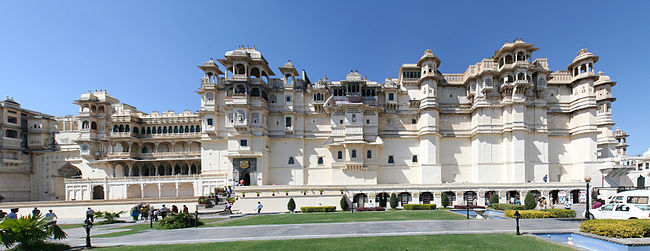
City Palace, Udaipur
The City Palace in Udaipur is a stunning architectural marvel and a symbol of the city’s royal heritage. Located on the eastern banks of Lake Pichola, it is the largest palace complex in Rajasthan. The construction of the palace began in 1559 by Maharana Udai Singh II and continued over 400 years, with contributions from successive rulers of the Mewar dynasty.
The palace complex is a blend of Rajasthani and Mughal architectural styles, featuring courtyards, pavilions, terraces, corridors, and hanging gardens. The main part of the palace is now preserved as a museum, exhibiting artifacts that provide insights into the royal lifestyle and history.
Key attractions within the City Palace include:
- Mor Chowk (Peacock Courtyard): Known for its intricate peacock mosaics, representing the three seasons of summer, winter, and monsoon.
- Zenana Mahal (Queen’s Palace): This section of the palace was the royal women’s quarters, adorned with exquisite paintings and decorative items.
- Sheesh Mahal (Palace of Mirrors): A beautifully decorated palace with intricate mirror work.
- Krishna Vilas: A chamber displaying a rich collection of miniature paintings.
- Badi Mahal (Great Palace): Situated on a 27-meter-high natural rock formation, it offers panoramic views of the surroundings.
- Fateh Prakash Palace: Now a heritage hotel, it houses the Crystal Gallery, showcasing a rare collection of crystal artifacts.
The City Palace, with its magnificent architecture and historical significance, is a must-visit for anyone exploring Udaipur. It offers a glimpse into the grandeur and opulence of Rajasthan’s royal past, making it an unforgettable experience.
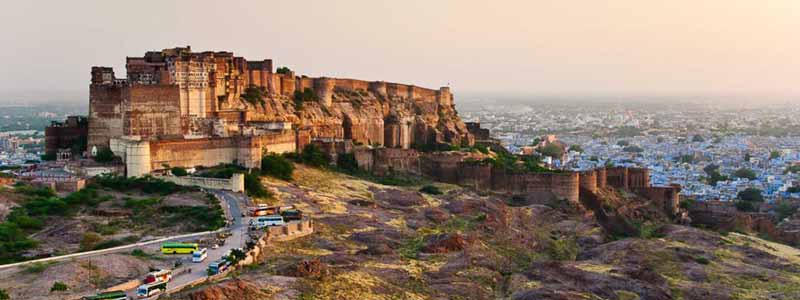
Mehrangarh Fort, Jodhpur
Mehrangarh Fort, one of the largest and most magnificent forts in India, is perched on a rugged hilltop overlooking the city of Jodhpur in Rajasthan. Founded by Rao Jodha in 1459, the fort stands as a testament to the architectural prowess and valor of the Rajput rulers.
The fort’s imposing walls, which rise up to 120 meters high, house several palaces known for their intricate carvings and expansive courtyards. Key attractions within the fort include:
- Moti Mahal (Pearl Palace): This palace is renowned for its royal throne, the Sringar Chowki, and its colorful stained-glass windows, which create a vibrant play of light.
- Phool Mahal (Flower Palace): The most opulent of the palaces, it was used as a private audience hall and features gold filigree work and elaborate paintings.
- Sheesh Mahal (Mirror Palace): Adorned with mirrors on the walls and ceilings, this palace showcases the intricate craftsmanship of the Rajput era.
- Chamunda Mataji Temple: This temple, dedicated to the goddess Chamunda, is a place of pilgrimage within the fort.
The fort also houses a museum that exhibits an impressive collection of artifacts, including royal palanquins, weaponry, costumes, and paintings. The ramparts of Mehrangarh Fort offer panoramic views of Jodhpur’s blue-painted houses and the surrounding Thar Desert.
Mehrangarh Fort’s grandeur, combined with its rich history and cultural significance, makes it a must-visit destination in Rajasthan, offering visitors a deep dive into the region’s royal past, Top 10 Heritage Places in Rajasthan.
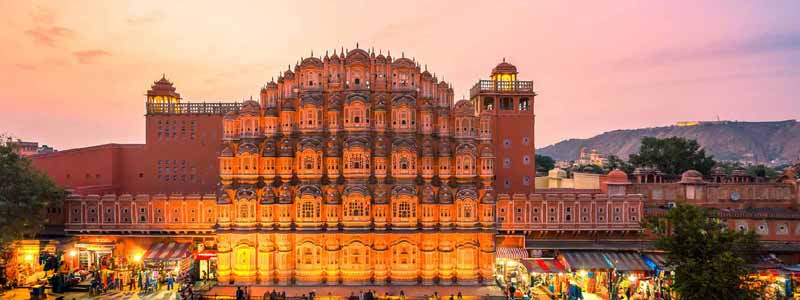
Hawa Mahal, Jaipur
Hawa Mahal, also known as the “Palace of Winds,” is one of Jaipur’s most iconic landmarks. Constructed in 1799 by Maharaja Sawai Pratap Singh, this distinctive building was designed by the architect Lal Chand Ustad in the form of a honeycomb, with 953 small windows or “jharokhas.” The palace is renowned for its unique façade, which allows for a cooling breeze to flow through the latticework, hence the name “Hawa Mahal.”
Key features of Hawa Mahal include:
- Facade: The most striking feature of Hawa Mahal is its ornate façade, decorated with intricate latticework and small balconies. The design allowed royal ladies to observe street festivities and daily life without being seen, adhering to the strict purdah system of the time.
- Interior: The interior of Hawa Mahal is less elaborate than the exterior but features a series of small chambers and courtyards. The focus of the design was more on the exterior aesthetics and ventilation.
- Views: The palace offers stunning views of the bustling streets of Jaipur from its numerous windows. The top of the palace provides a panoramic view of the city and the nearby City Palace.
- Architectural Style: The palace is a fine example of Rajput architecture with a blend of Hindu and Mughal elements. The use of red and pink sandstone complements the surrounding structures of Jaipur, earning it the nickname “Pink City.”
Hawa Mahal is not just a significant historical building but also a symbol of Jaipur’s rich cultural heritage. Its unique architecture and historical importance make it a must-see for visitors to the city.
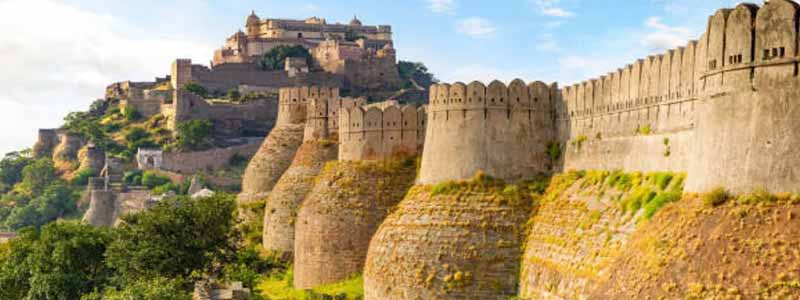
Kumbhalgarh Fort, Rajsamand
Kumbhalgarh Fort, located in the Rajsamand district of Rajasthan, is a majestic and historically significant fort renowned for its massive walls and impressive architecture. Built in the 15th century by Maharana Kumbha, a ruler of the Mewar dynasty, the fort stands on the Aravalli Range, approximately 85 kilometers northwest of Udaipur.
Here are some notable features of Kumbhalgarh Fort:
- Great Wall: The fort is famous for its massive walls, which stretch over 36 kilometers and are among the longest in the world. The walls are wide enough to allow eight horses to trot side by side and are fortified with numerous bastions and watchtowers.
- Architectural Style: The fort showcases a blend of Rajput and Mughal architectural styles. Its design includes elaborate courtyards, temples, and palaces, all set within the fort’s extensive fortifications.
- Temples: Kumbhalgarh Fort houses several ancient temples, including the famous Neelkanth Mahadev Temple, dedicated to Lord Shiva, and the Vedi Temple, known for its intricate carvings.
- Badal Mahal: This palace within the fort is renowned for its exquisite murals and beautiful frescoes. The name “Badal Mahal” translates to “Cloud Palace,” reflecting the palace’s location amidst the clouds and mist.
- Wildlife: The Kumbhalgarh Fort is surrounded by the Kumbhalgarh Wildlife Sanctuary, which is home to various species of flora and fauna, including leopards, wolves, and deer.
- Historical Significance: The fort played a crucial role in the defense of the Mewar kingdom against invaders and was a strategic military stronghold. It has witnessed numerous battles and sieges over the centuries.
Kumbhalgarh Fort is a UNESCO World Heritage Site and an exceptional example of Rajput military architecture. Its impressive fortifications and historical significance make it a must-visit destination for history enthusiasts and travelers exploring Rajasthan.
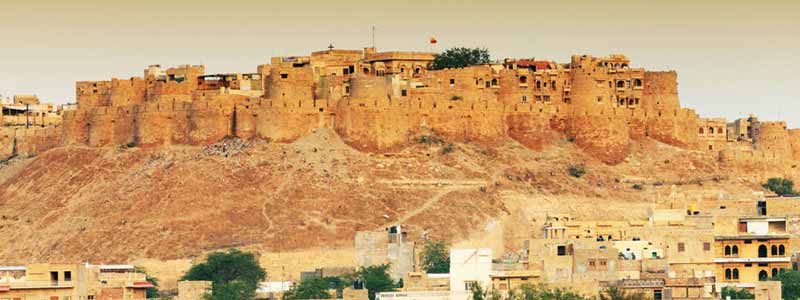
Jaisalmer Fort, Jaisalmer
Jaisalmer Fort, also known as Sonar Quila or the Golden Fort, is one of the most remarkable and well-preserved forts in Rajasthan. Located in the heart of the Thar Desert, this fort stands out for its stunning yellow sandstone architecture, which gives it a golden hue, especially at sunset. Built in 1156 AD by Raja Jaisal, the fort is a UNESCO World Heritage Site and a symbol of Jaisalmer’s rich history and heritage.
Key features of Jaisalmer Fort include:
- Architectural Design: The fort is built with golden-yellow sandstone, which blends seamlessly with the desert surroundings, giving it a golden appearance. The fort’s intricate carvings and ornate decorations showcase the grandeur of Rajput architecture.
- Living Fort: Unlike many other forts, Jaisalmer Fort is a “living fort,” meaning it houses a vibrant community. It includes residential areas, shops, and even temples. The fort is home to several families and continues to be an integral part of Jaisalmer’s daily life.
- Raj Mahal (Royal Palace): The palace within the fort includes various rooms, courtyards, and balconies. It served as the residence of the Maharajas of Jaisalmer and features impressive frescoes and intricately carved wooden screens.
- Temples: The fort contains several ancient Jain temples, including the Dilwara Temples, known for their exquisite marble carvings. These temples are important pilgrimage sites and add to the fort’s spiritual significance.
- Havelis: The fort is surrounded by several grand havelis (mansions) with elaborately carved facades, such as the Patwon Ki Haveli and Salim Singh Ki Haveli. These havelis reflect the opulence and artistic sensibilities of the merchant families who lived in Jaisalmer.
- History and Defense: Jaisalmer Fort has historically been a strategic military fortification, guarding the trade routes of the Thar Desert. It has withstood numerous sieges and attacks, making it a testament to Rajput valor and resilience.
Jaisalmer Fort’s unique architecture, vibrant culture, and historical significance make it a must-visit destination for travelers interested in exploring Rajasthan’s rich heritage, Top 10 Heritage Places in Rajasthan.
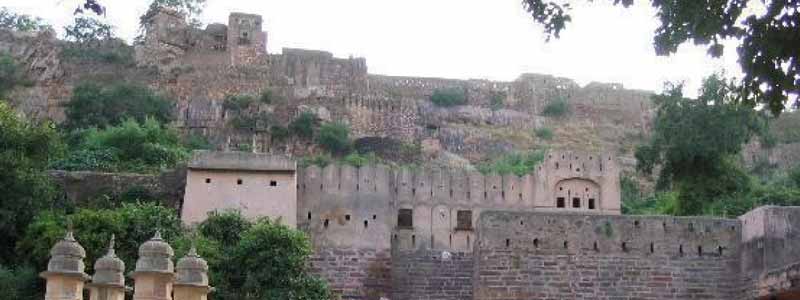
Ranthambore Fort, Sawai Madhopur
Ranthambore Fort, located in Sawai Madhopur, Rajasthan, is a historic fort situated within the Ranthambore National Park. It stands on a hilltop, offering a panoramic view of the surrounding landscapes and the wildlife sanctuary below. The fort has a rich history and is an important part of Rajasthan’s heritage.
Here are some notable features of Ranthambore Fort:
- Historical Significance: Built in the 10th century by the Chauhan dynasty, Ranthambore Fort has witnessed numerous battles and sieges. It was an important strategic location during the medieval period and played a significant role in the region’s history.
- Architectural Features: The fort is a blend of Rajput and Mughal architectural styles. It includes impressive structures such as gateways, temples, and palaces. The fort’s architecture reflects its military significance and historical grandeur.
- Temples: The fort houses several ancient temples, including the Raja Ganesh Temple, Shiv Temple, and Santoshi Mata Temple. These temples are known for their intricate carvings and historical importance.
- Defensive Walls and Gates: The fort’s defensive features include strong walls and several gates, such as the Andheri Gate and Hanuman Gate, which were designed to protect against invasions.
- Wildlife Sanctuary: The fort is located within Ranthambore National Park, one of India’s largest and most famous wildlife sanctuaries. The park is known for its population of Bengal tigers, and the fort provides a unique vantage point to view both the wildlife and the landscape.
- Panoramic Views: From the fort, visitors can enjoy breathtaking views of the surrounding park and the diverse wildlife habitats. The elevated position of the fort offers a scenic perspective of the lush greenery and rugged terrain of the region.
- Cultural Importance: Ranthambore Fort is a UNESCO World Heritage Site and is recognized for its cultural and historical significance. It is a popular attraction for history enthusiasts and wildlife lovers alike.
The fort’s combination of historical architecture and natural beauty makes it a unique and fascinating destination. It serves as a reminder of Rajasthan’s rich history while providing an excellent vantage point for observing the natural beauty of Ranthambore National Park.
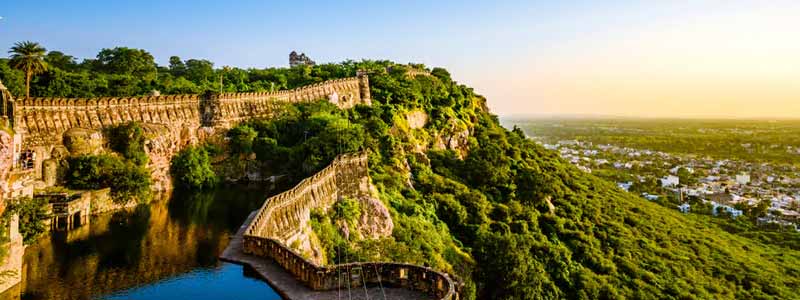
Chittorgarh Fort, Chittorgarh
Chittorgarh Fort, located in Chittorgarh, Rajasthan, is one of the largest and most impressive forts in India. Covering an area of about 700 acres, this UNESCO World Heritage Site stands as a symbol of Rajput valor and pride. The fort is situated on a hilltop, offering a commanding view of the surrounding landscape.
Here are some notable features of Chittorgarh Fort:
- Historical Significance: Chittorgarh Fort has a rich history, having been the capital of the Mewar kingdom. It has witnessed several historic battles, including those against the Delhi Sultanate and the Mughal Empire. The fort is renowned for its association with the legendary Rajput queen, Rani Padmini.
- Architectural Features: The fort’s architecture showcases a blend of Rajput and Mughal styles. Its massive walls, towering bastions, and intricate carvings reflect the fort’s strategic and defensive significance.
- Palaces: The fort houses several notable palaces, including the Vijay Stambh (Victory Tower), which was built by Maharaja Kumbha to commemorate his victory over Mahmud Khilji. The Rani Padmini Palace and Rani Kumbha Palace are also significant landmarks within the fort.
- Temples: Chittorgarh Fort includes numerous temples dedicated to Hindu deities. Notable ones include the Kumbheshwar Temple, Meera Temple, and Kalika Mata Temple. These temples are known for their architectural beauty and historical importance.
- Water Bodies: The fort has several ancient reservoirs and stepwells, such as the Jauhar Kund and Rani Padmini’s Palace Stepwell, which were essential for the fort’s water supply and are remarkable examples of ancient engineering.
- Historical Events: The fort is renowned for the Jauhar (self-immolation) performed by Rajput women and children during the siege by Alauddin Khilji in 1303. The fort’s history of heroism, sacrifice, and resilience is a testament to Rajput bravery.
- Cultural Heritage: Chittorgarh Fort is not only a historical monument but also a cultural symbol of Rajput heritage. It hosts various events and festivals that celebrate the region’s history and traditions.
Chittorgarh Fort’s grandeur, historical significance, and architectural brilliance make it a must-visit destination for those interested in India’s rich cultural and historical heritage. The fort’s expansive complex and its dramatic history offer a fascinating glimpse into Rajasthan’s past Top 10 Heritage Places in Rajasthan.
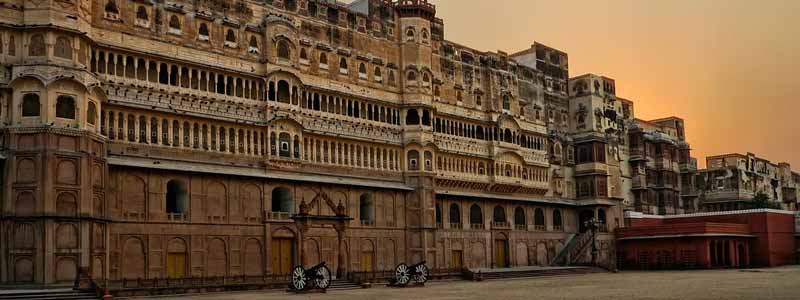
Junagarh Fort, Bikaner
Junagarh Fort, located in Bikaner, Rajasthan, is a stunning example of Rajput military architecture and one of the most well-preserved forts in India. Built between 1588 and 1593 by Raja Rai Singh, a general in the Mughal Emperor Akbar’s army, the fort stands on a rocky ridge and is surrounded by a moat.
The fort is renowned for its impressive design and intricate artistry. Key features include:
- Architectural Brilliance: Junagarh Fort boasts a blend of Rajput, Mughal, and Persian architectural styles. Its grand entrance, massive walls, and intricately carved facades showcase the craftsmanship of the era.
- Palaces: The fort houses several exquisite palaces, including Karan Mahal, Anup Mahal, and Ratan Mahal, each with its unique design and decor. Karan Mahal is known for its ornate mirrors and glasswork, while Anup Mahal is celebrated for its elegant interiors.
- Temples and Havelis: The fort also features beautiful temples and havelis, reflecting the religious and cultural aspects of the time.
- Museums: Junagarh Fort includes a museum displaying royal artifacts, weapons, and historical relics, providing insights into the fort’s rich history.
- Panoramic Views: The fort’s elevated position offers panoramic views of Bikaner and the surrounding desert landscape.
Junagarh Fort is a testament to Rajasthan’s rich heritage and architectural ingenuity, making it a must-visit for history enthusiasts and travelers Top 10 Heritage Places in Rajasthan.
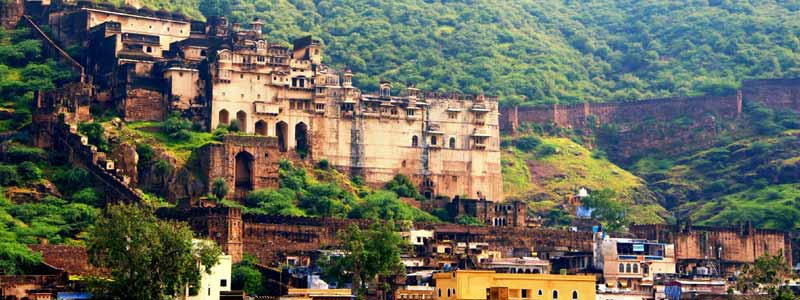
Bundi Palace, Bundi
Bundi Palace, located in Bundi, Rajasthan, is a magnificent example of Rajput architecture and a testament to the city’s rich history. Built between the 16th and 17th centuries by the Bundi rulers, the palace is situated atop a hill, offering splendid views of the surrounding landscape.
Here are some notable features of Bundi Palace:
- Architectural Style: The palace showcases a distinctive Rajput architectural style with its intricately carved balconies, ornate courtyards, and vibrant frescoes. Its design reflects a blend of Mughal and traditional Rajput influences.
- Chandralok and Phool Mahal: The palace includes the Chandralok Mahal, renowned for its exquisite mirror work and frescoes depicting scenes from Rajput life. The Phool Mahal (Flower Palace) is another highlight, known for its beautiful floral designs and elegant decor.
- Keshar Mahal: This part of the palace is famous for its lavish interiors and elaborate carvings, offering a glimpse into the opulence of the Bundi rulers.
- Frescoes and Paintings: Bundi Palace is renowned for its stunning frescoes and murals, which cover the walls and ceilings of various rooms. These artworks depict historical events, hunting scenes, and courtly life.
- Rani Sati’s Palace: The palace complex includes the Rani Sati Palace, dedicated to the queen mother, and features intricate carvings and beautiful courtyards.
- Towers and Fortifications: Bundi Palace is surrounded by impressive fortifications and towers, enhancing its defensive capabilities and adding to its grandeur.
- Stepwells: The palace complex includes several ancient stepwells, such as Rani Ki Baori, showcasing the advanced water management systems of the time.
Bundi Palace is a remarkable destination for those interested in Rajasthan’s royal history and architecture. Its well-preserved frescoes, regal design, and panoramic views make it a captivating site for visitors.







